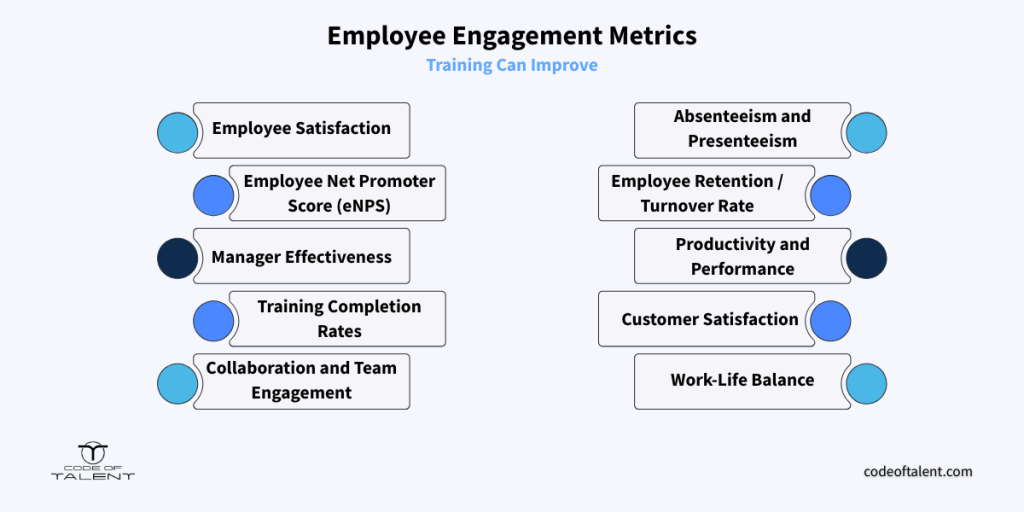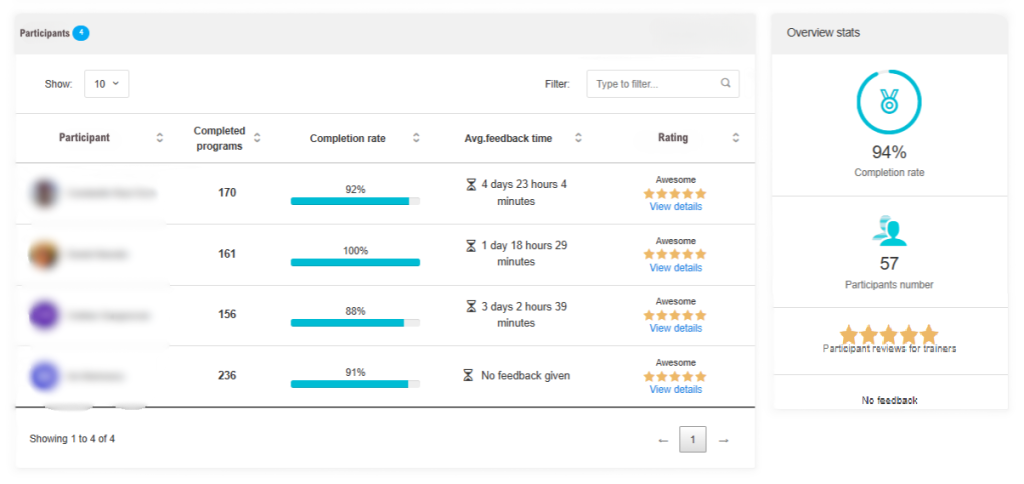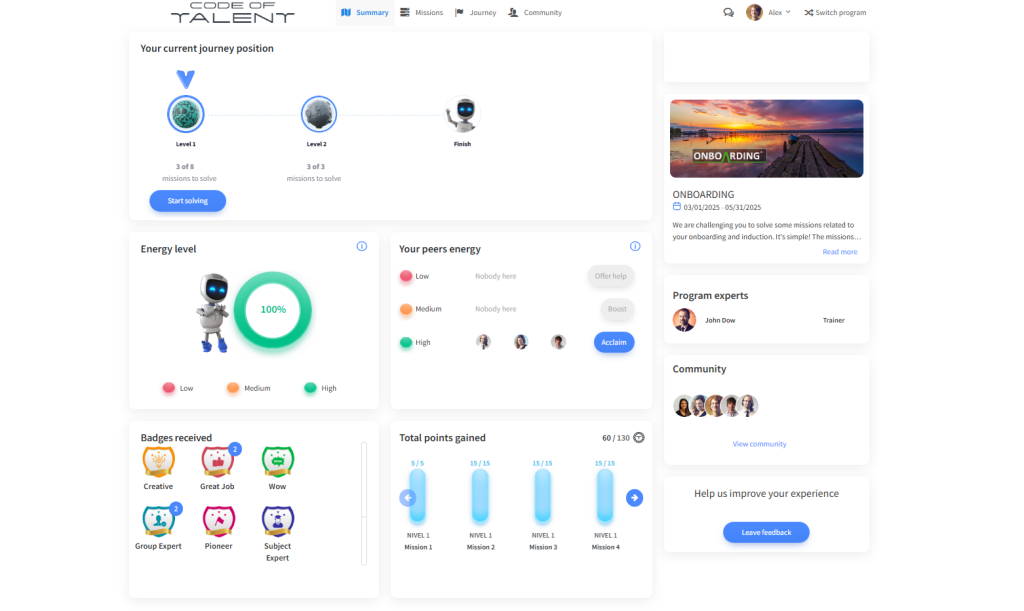A third of employees are simply not engaged at work. And this disengagement costs companies in the U.S. up to $550 billion every year, according to a study reported by HR Dive. Despite the alarming numbers, there are practical ways to improve employee engagement metrics, and one of them is hiding in plain sight: training and development.

When people feel like they’re learning and growing, they’re more likely to stay motivated and invested in their work. There’s solid evidence to back this up: a study published in Public Personnel Management based on data from the U.S. Federal Employee Viewpoint Survey found a clear, positive link: the more access employees had to training and development, the more engaged they were across the board.
So, what exactly are the employee engagement metrics that training can improve? In this article, we’ll break down those key metrics and share practical examples of training programs that make a real difference.
Why It’s Important to Track Employee Engagement Metrics
Measuring employee engagement means understanding what’s working, what’s not, and what needs to change, on both the employee and company level.
For the Employee
These employee engagement metrics offer a window into behavior patterns:
- Are they on track for a promotion?
- Are they stagnating?
- Are they happy with their team?
- Do they feel like their job matters?
- Are they likely to walk out the door?
With that insight, HR can take action before it’s too late.
For the Company
Better engagement means better business. Studies proved that engaged and motivated employees bring benefits to the company. For example, according to Deloitte, a 15% boost in engagement can lead to a 2% increase in profit margins. Plus, 56% of organizations that invest in engagement see a positive ROI, as shown by Quantum Workplace.
How Training Improves Key Employee Engagement Metrics
Training programs aren’t just about learning how to use software or mastering a new technique. When done right, they make employees feel more connected, capable, and valued.
Below are ten essential engagement metrics that training can help improve. Each section unpacks the what, how, and why, plus a practical tip to get started.

1. Employee Satisfaction
What It Is: Employee satisfaction reflects how happy, content, and motivated employees feel in their roles. It’s a foundational metric because satisfied employees are more likely to stay, perform, and advocate for their organization.
How It’s Measured: It’s commonly tracked through regular surveys, sentiment analysis from employee feedback platforms, and 1:1 interviews.
How Training Helps: Training plays a big role in helping employees feel like they’re moving forward. It improves clarity in their roles, supports personal growth, and shows them that the company values their contribution.
In a study of 200 employees published in the International Journal of Business, Law and Education, researchers found a strong link between job satisfaction and access to training and career development opportunities. According to their findings, companies that invest in meaningful training and clear growth paths tend to have more satisfied and more engaged employees.
Tip: Offer Role-Specific Skills Training
Every role is different, and the “one-size-fits-all” training model is no longer relevant for today’s workplace environment. Whether it’s in-depth product training for sales reps or safety training for construction teams, role-specific training helps people feel more capable and confident in what they do.
2. Employee Net Promoter Score (eNPS)
What It Is: This metric shows how likely employees are to recommend their company as a great place to work.
How It’s Measured: eNPS is calculated using a simple survey question: “On a scale from 0 to 10, how likely are you to recommend this company as a place to work?” eNPS are the difference between promoters (9–10) and detractors (0–6).
How Training Helps: Employees who feel they are growing and supported are far more likely to become promoters. Training shows that the company is invested in their long-term development, not just short-term output.
Tip: Run Values-Based Onboarding Training
Kick things off with onboarding that clearly communicates the company’s mission, values, and growth pathways. This sets a strong tone early and creates loyal advocates from day one.
Plus, first impressions always spread to other people outside the company: new hires share their experience with their friends, relatives, or online, which can greatly influence future candidates.
3. Manager Effectiveness
What It Is: This measures how well managers lead, support, and communicate with their teams. Strong managers are often the backbone of an engaged workforce. On the other hand, toxic leadership leads to people losing motivation, which turns into turnover if left unchecked. For example, Robert Half found that 49% of U.S. employees have quit a job due to a poor relationship with their manager.
How It’s Measured: Through 360-degree feedback, direct report surveys, and performance evaluations tied to team morale and performance.
How Training Helps: Leadership isn’t always intuitive. Many team leaders are subject matter experts rather than natural-born leaders, and therefore need support in developing both their technical and soft skills. Managers benefit from formal training in communication, emotional intelligence, and coaching.
Tip: Offer Leadership and Coaching Skills Training
Train managers to hold meaningful 1:1s, deliver effective feedback, and promote psychological safety in their teams. These are the tools that turn bosses into leaders.
4. Training Completion Rates
What It Is: This looks at how many employees complete assigned training and how engaged they are throughout.
How It’s Measured: Tracked through Learning Management Systems (LMS), it includes completion percentages, participation levels, quiz scores, and time spent per module.

How Training Helps: Engaging content drives higher completion rates. If training is boring or irrelevant, employees tend to skim, click through without focus, or half-listen. On the other side, interactive and relevant training not only keeps learners involved, it also encourages them to seek out more.
Tip: Use Interactive eLearning Modules
Incorporate gamification, branching scenarios, and quizzes to create engaging and fun learning experiences employees actually enjoy.

5. Collaboration and Team Engagement
What It Is: This metric reflects how well employees work together, how connected they feel to their team, and whether they communicate effectively.
How It’s Measured: Measured through peer feedback, collaboration tool usage (like Slack or MS Teams), and team performance data.
How Training Helps: Team-building and communication training strengthens trust and clarity. It helps teams resolve conflict, align around goals, and build a sense of camaraderie that would otherwise not be exercised during stressful working conditions.
Tip: Provide Communication Training
Offer hands-on training around giving/receiving feedback, group problem-solving, and understanding team dynamics.
6. Absenteeism and Presenteeism
What It Is: Absenteeism is frequent or unexpected absence from work. Presenteeism is when employees are at work but mentally checked out, usually due to stress or poor health.
How It’s Measured: Organizations track it using attendance records, HR reporting, and manager observations.
How Training Helps: When employees feel supported and have tools to manage stress, they’re more likely to show up, and most importantly, show up engaged. For instance, Gallup research found that highly engaged business units see 81% lower absenteeism and 14% higher productivity.
Tip: Run Wellbeing and Stress Management Training
Offer training on mindfulness, time management, and burnout prevention. A little support can go a long way toward keeping employees healthy and present.
7. Employee Retention / Turnover Rate
What It Is: Retention refers to how many employees stay at a company over time. Turnover is the opposite: how many employees left a company over a specific period.
How It’s Measured: Retention Rate = (Number of employees who stayed / Number at the start of period) × 100

How Training Helps: Employees who see a future at a company are more likely to stay. LinkedIn’s 2023 Workplace Learning Report shows that 94% of employees say they’d stay longer if their company invested in their learning and development. Training helps employees develop their abilities, skills, and knowledge, which is essential in career advancement.
Tip: Implement Career Pathway Training
Create clear training plans for internal promotions. If employees can visualize their next step, they’ll stick around.
8. Productivity and Performance
What It Is: This measures how efficiently employees meet their goals and contribute to business outcomes.
How It’s Measured: Tracked through KPIs, team output metrics, sales performance, or customer service ratings.
How Training Helps: Forbes reports that engaged employees are 17% more productive. Training helps employees work smarter, not harder, by giving them strategies for time management, focus, and performance improvement.
Tip: Provide Efficiency Training
Offer training on techniques like prioritization, deep work, and digital organization to help employees get more done in less time.
9. Customer Satisfaction
What It Is: Customer satisfaction reflects how well a team meets customer expectations. Happy customers are a direct result of engaged employees.
How It’s Measured: Typically tracked through customer satisfaction scores (CSAT), Net Promoter Scores (NPS), and post-interaction surveys.
How Training Helps: Salesforce found that 94% of customers are more likely to make another purchase after a positive service experience. Customer-facing employees need training in product knowledge, problem solving, and active listening to consistently deliver that experience.
Tip: Provide Customer Service and Empathy Training
Train staff to handle challenges with care and precision. Every industry has its difficulties in engaging with clients. Healthcare workers may need to deliver sensitive news with empathy and respect. Retail staff are expected to stay positive and helpful regardless of a customer’s tone. Logistics or delivery workers must respect people’s time and privacy.
So, these customer-facing skills shouldn’t be left to chance but developed through clear, intentional training.
10. Work-Life Balance
What It Is: This metric reflects how well employees can manage their professional duties alongside their personal lives. It’s becoming a top priority in engagement conversations.
How It’s Measured: Measured through employee engagement surveys, wellness scores, and data around burnout or time off.
How Training Helps: Teaching employees how to manage their time, set boundaries, and protect their mental health leads to a healthier balance and a more sustainable work culture.
Tip: Offer Time Management and Stress Reduction Training
Hold workshops on setting boundaries, identifying burnout, and encouraging speaking out when too much is too much.
Conclusion: Train to Retain and Thrive
Employee engagement metrics aren’t just numbers but signals. They show that people want to grow, to be seen, and to be supported.
Training has a real impact on what drives a healthy workplace, such as satisfaction, retention, and performance. And with a platform like Code of Talent, you’re equipping your teams with more than just information. You’re giving them meaningful, day-to-day learning experiences to strengthen engagement and workplace culture.
With Code of Talent, you can tackle many of the engagement challenges discussed above:
- Use interactive training formats to improve completion and retention
- Design role-based custom training paths for career progression and retention
- Provide upskilling training for employees and team leads
- Deliver well-being content to reduce absenteeism and presenteeism
- Track performance across all metrics using real-time analytics
Start your free trial today and see how Code of Talent can help you turn every employee engagement metric into a growth opportunity!
Cover photo: Freepik





